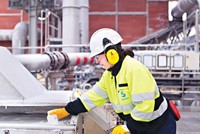Advertisement
Grab your lab coat. Let's get started
Welcome!
Welcome!
Create an account below to get 6 C&EN articles per month, receive newsletters and more - all free.
It seems this is your first time logging in online. Please enter the following information to continue.
As an ACS member you automatically get access to this site. All we need is few more details to create your reading experience.
Not you? Sign in with a different account.
Not you? Sign in with a different account.
ERROR 1
ERROR 1
ERROR 2
ERROR 2
ERROR 2
ERROR 2
ERROR 2
Password and Confirm password must match.
If you have an ACS member number, please enter it here so we can link this account to your membership. (optional)
ERROR 2
ACS values your privacy. By submitting your information, you are gaining access to C&EN and subscribing to our weekly newsletter. We use the information you provide to make your reading experience better, and we will never sell your data to third party members.
Business
Biodiesel catalyst ranks to expand
Seeing more growth ahead, two small companies invest in new plants
by Michael McCoy
April 15, 2016
| A version of this story appeared in
Volume 94, Issue 16

Growth in the biodiesel market is spurring two small companies to invest in U.S. production of sodium methylate, a catalyst used to convert fats and oils into the renewable fuel. These Davids will be going up against two biodiesel catalyst Goliaths, the German chemical makers BASF and Evonik Industries.
New Heaven Chemicals is starting up a plant in Manly, Iowa, that will make 18,000 metric tons per year of sodium methylate for biodiesel industry customers. Prasad Devineni, the firm’s director, says the plant is being commissioned and should be running in the next few weeks.
Although New Heaven will be new to U.S. production, its parent company, India’s TSS Group, has been importing sodium methylate from Saudi Arabia since 2006, Devineni notes. New Heaven anticipates building a second, similarly sized, sodium methylate plant in Houston.
Meanwhile, Interstate Chemical is advancing plans to produce sodium methylate in Erie, Pa., to serve customers such as the nearby firm Hero BX, which calls itself the largest biodiesel maker east of the Mississippi.
Interstate says it will spend $60 million to build plants for sodium methylate and methanol, the latter of which is reacted with sodium hydroxide to make the catalyst. Interstate has been producing sodium methylate for close to 10 years using an older process that starts with sodium metal. The firm’s plan to invest in the newer route follows DuPont’s decision to close its sodium facility in Niagara Falls, N.Y.
U.S. biodiesel consumption has enjoyed a meteoric rise from less than 100 million L in 2004 to almost 8 billion L in 2015, according to the National Biodiesel Board. During those years, Evonik erected sodium methylate plants in Alabama and Argentina. BASF built in Argentina and Brazil.
However, the years ahead may not be as heady for the catalyst newcomers. U.S. imports of biodiesel are on the increase. And a growing portion of biodiesel is so-called renewable diesel, which is made via a hydrotreating process that doesn’t require sodium methylate.




Join the conversation
Contact the reporter
Submit a Letter to the Editor for publication
Engage with us on Twitter